NCERT Exemplar Class 6 Maths Chapter 6 Mensuration are part of NCERT Exemplar Class 6 Maths. Here we have given NCERT Exemplar Class 6 Maths Solutions Chapter 6 Mensuration.
NCERT Exemplar Class 6 Maths Chapter 6 Mensuration
Directions: In questions 1 to 6, out of the four options only one is correct. Write the correct answer.
Question 1.
Following figures are formed by joining six unit squares. Which figure has smallest perimeter?

(A) (ii)
(B) (iii)
(C) (iv)
(D) (i)
Solution:
(D) : Perimeter of figure (i) = 10 units
Perimeter of figure (ii) = 12 units
Perimeter of figure (iii) = 14 units
Perimeter of figure (iv) = 14 units
So, figure (i) has smallest perimeter.
Question 2.
A square shaped park ABCD of side 100 m has two equal rectangular flower beds each of size 10 m × 5 m (see figure). Length of the boundary of the remaining park is
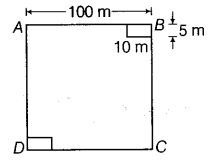
(A) 360 m
(B) 400 m
(C) 340 m
(D) 460 m
Solution:
(B): Length of required boundary = Perimeter of remaining park
= 90 m + 95 m + 10 m + 5 m + 90 m
= 400 m
Question 3.
The side of a square is 10 cm. How many times will the new perimeter become if the side of the square is doubled?
(A) 2 times
(B) 4 times
(C) 6 times
(D) 8 times
Solution:
(A) : Side of square = 10 cm
Perimeter of square = 4 × 10 cm =40 cm …… (i)
Now, new side of square
= 2 × 10 cm = 20 cm
∴ Perimeter of new square = 4 × 20 cm = 80 cm
= 2 × 40 cm …… (ii)
∴ (i) and (ii) shows that the new perimeter will be 2 times of the perimeter of given square.
Question 4.
Length and breadth of a rectangular sheet of paper are 20 cm and 10 cm, respectively. A rectangular piece is cut from the sheet as shown in figure. Which of the following statements is correct for the remaining sheet?

(A) Perimeter remains same but area changes.
(B) Area remains the same but perimeter changes.
(C) Both area and perimeter are changing.
(D) Both area and perimeter remain the same.
Solution:
(A) : The given figure shows that perimeter will remain same but area changes.
Question 5.
Two regular hexagons of perimeter 30 cm each are joined as shown in figure. The perimeter of the new figure is

(A) 65 cm
(B) 60 cm
(C) 55 cm
(D) 50 cm
Solution:
(D) : Perimeter of a regular hexagon = 6 × side
⇒ 30 cm = 6 × side
⇒ \(=\frac{30}{6} \mathrm{cm}=5 \mathrm{cm}\)
∴ Each side of a regular hexagon = 5 cm
∴ The perimeter of the new figure = 10 × side = 10 × 5 cm = 50 cm
Question 6.
In the given figure, which of the following is a regular polygon? All have equal side except (i)

(A) (i)
(B) (ii)
(C) (iii)
(D) (iv)
Solution:
(B) : Since, we know that in a regular polygon all angles and all sides are equal. Thus figure (ii) satisfies the above condition.
Question 7.
Match the shapes (each side measures 2 cm) in column I with the corresponding perimeters in column II:
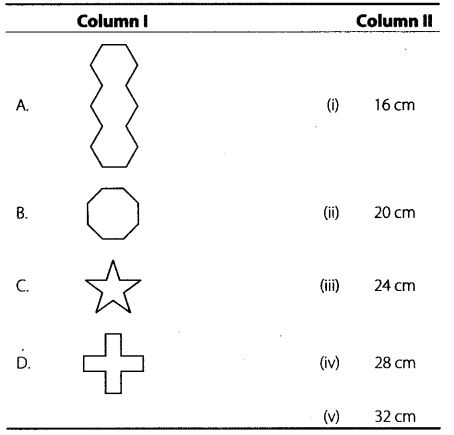
Solution:
(A) ➝ (iv); (B) ➝ (i); (C) ➝ 4 (ii); (D) ➝ (iii)
(A) The given figure has 14 sides.
Each side measures 2 cm.
∴ The perimeter of the given figure = 14 × 2 cm = 28 cm
(B) The given figure has 8 sides.
∴ The perimeter of the given figure = 8 × 2 cm = 16 cm
(C) The given figure has 10 sides.
∴ The perimeter of the given figure = 10 × 2 cm = 20 cm
(D) The given figure has 12 sides.
∴ The perimeter of the given figure = 12 × 2 cm = 24 cm
Question 8.
Match the following :
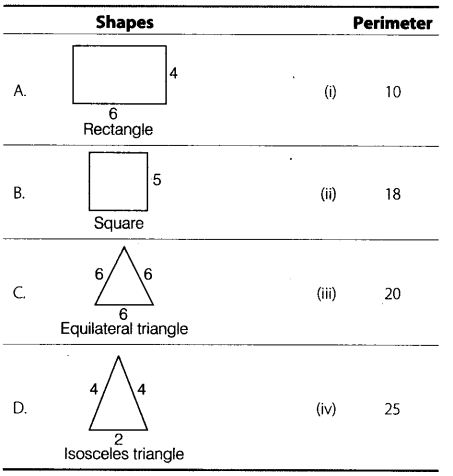
Solution:
(A) ➝ (iii); (B) ➝ (iii); (C) ➝ (ii) (D) ➝ (i)
= 2 (length + breadth)
= 2(6+ 4) = 2(10) = 20
(B) Perimeter of a square = 4 * side = 4 x 5 = 20
(C) Perimeter of an equilateral triangle = 3 x side = 3×6 = 18
(D) Perimeter of an isosceles triangle = Sum of all sides = 4 + 2 + 4 = 10
Directions: In questions 9 to 13, fill in the blanks to make the statements true.
Question 9.
Perimeter of the shaded portion in the given figure is
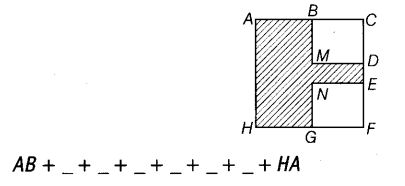
Solution:
BM, MD, DE, EN, NG, GH: Perimeter of the shaded portion of the given figure
= AB + BM + MD + DE + EN + NG + GH + HA
Question 10.
The amount of region enclosed by a plane dosed figure is called its _____.
Solution:
Area
Question 11.
Area of rectangle with length 5 cm and breadth 3 cm is ____.
Solution:
15 cm2: Area of a rectangle
= length × breadth = (5 × 3) cm2 = 15 cm2
Question 12.
A rectangle and a square have the same perimeter (see figure).
(a) The area of the rectangle is ____.
(b) The area of the square is ____.
Solution:

(a) 12 sq units : Area of a rectangle
= length × breadth
= (6 × 2) sq units = 12 sq units
(b) 16 sq units : We have given,
Perimeter of a rectangle = Perimeter of a square
⇒ 2(length + breadth) = 4 × side ⇒ 2(6 + 2) = 4 × side ⇒ 2(8) = 4 × side
⇒ \(\frac{16}{4}\) = side ⇒ side = 4 units
∴ The area of square = side × side
= (4 × 4) sq units = 16 sq units
Question 13.
(a) 1m = ___ cm.
(b) 1 sq cm = ____cm × 1 cm.
(c) 1 sq m = 1 m × ___ m
= 100 cm × cm.
(d) 1 sq m = ___ sq cm
Solution:
(a) 100 : 1 m = 100 cm
(b) 1 : 1 sq cm = 1 cm × 1 cm
(c) 1 and 100 : 1 sq m = 1 m × 1 m
= 100 cm × 100 cm
(d) 10000 : 1 sq m = 10000 sq cm
Directions: In questions 14 to 20, state which of the statements are true and which are false.
Question 14.
If length of rectangle is halved and breadth is doubled then the area of the rectangle obtained remains same.
Solution:
True
Let l and b are the dimensions of a given rectangle, whereas l’ and b’ are the dimensions of a new rectangle.
According to question, \(l^{\prime}=\frac{1}{2} l \text { and } b^{\prime}=2 b\)
Area of new rectangle \(=l^{\prime} b^{\prime}=\frac{1}{2} l \times 2 b=l b\), which is the area of the given rectangle.
Question 15.
Area of square is doubled if the side of the square is doubled.
Solution:
False
Let the side of a given square be a.
∴ Area of the square = a2
The side of a new square = 2a
∴ Area of the new square = (2a)2 = 4a2
which concludes that the area of the new square is four times the area of the given square.
Question 16.
Perimeter of a regular octagon of side 6 cm is 36 cm.
Solution:
False
Side of a regular octagon = 6 cm
Perimeter of a regular octagon = 8 × side = 8 × 6 cm = 48 cm
Question 17.
A farmer who wants to fence his field, must find the perimeter of the field.
Solution:
True
Question 18.
An engineer who plans to build a compound wall on all sides of a house must find the area of the compound.
Solution:
False
To build a compound wall on all sides of a house, the engineer must find the perimeter of the compound.
Question 19.
To find the cost of painting a wall we need to find the perimeter of the wall.
Solution:
False
Question 20.
To find the cost of a frame of a picture, we need to find the perimeter of the picture.
Solution:
True
Question 21.
Four regular hexagons are drawn so as to form the design as shown in the figure. If the perimeter of the design is 28 cm, find the length of each side of the hexagon.

Solution:
The perimeter of the design = 28 cm
⇒ 14 × side = 28 cm
⇒ side \(=\frac{28}{14} \mathrm{cm}=2 \mathrm{cm}\)
Question 22.
Perimeter of an isosceles triangle is 50 cm. If one of the two equal sides is 18 cm, find the third side.
Solution:
Let ∆ABC be the given isosceles triangle, where AB = CA = 18 cm.
Perimeter of the ∆ABC = 50 cm
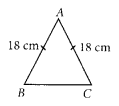
⇒ AB + BC + CA = 50 cm
⇒ 18 cm + BC + 18
⇒ 36 cm + BC = 50 cm
⇒ BC = 50 cm – 36 cm
⇒ BC = 14 cm
Question 23.
Length of a rectangle is three times its breadth. Perimeter of the rectangle is 40 cm. Find its length and width.
Solution:
Let l and b are length and breadth respectively of the given rectangle.
According to question, l = 3b
Perimeter of the rectangle = 2(1 + b)
⇒ 40 cm = 2(3b + b)
⇒ 40 cm = 2 × 4b ⇒ 40 cm = 8b
⇒ \(\frac{40}{8} \mathrm{cm}=b \quad \Rightarrow \quad b=5 \mathrm{cm}\)
∴ The required length = 3 × 5 cm = 15 cm and breadth = 5 cm
Question 24.
There is a rectangular lawn 10 m long and 4 m wide in front of Meena’s house (see figure). It is fenced along the two smaller sides and one longer side leaving a gap of 1 m for the entrance. Find the length of fencing.
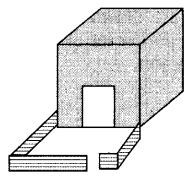
Solution:
Length of rectangular lawn = 10 m
And breadth of rectangular lawn = 4 m
The length of fencing along the two smaller sides of lawn = 4m + 4m = 8 m
Question 25.
The region given in the following figure is measured by taking
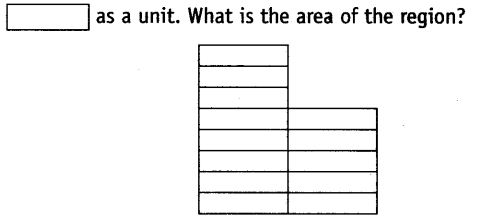
Solution:
Since, in the given figure there are 13 rectangular shapes.
∴ Area of the region = 13 sq units.
Question 26.
Tahir measured the distance around a square field as 200 rods (lathi). Later he found that the length of this rod was 140 cm. Find the side of this field in metres.
Solution:
The perimeter of a square field = the distance around a square field
⇒ 4 × side = length of 200 rods
⇒ 4 × side = 200 × 140 cm
[ ∵ The length of the rod = 140 cm]
⇒ side \(=\frac{200 \times 140}{4} \mathrm{cm}\)
⇒ side \(=7000 \mathrm{cm}=\frac{7000}{100} \mathrm{m}=70 \mathrm{m}\)
∴ The side of the field = 70 m
Question 27.
The length of a rectangular field is twice its breadth. Jamal jogged around it four times and covered a distance of 6 km. What is the length of the field?
Solution:
We have given,
The length of a rectangular field = 2 (breadth)
The perimeter of field = 2(length + breadth)
∵ Jamal jogged around it 4 times and covered a distance of 6 km.
∴ 4[2(length + breadth)] = 6 km
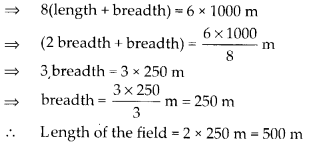
Question 28.
Three squares are joined together as shown in figure. Their sides are 4 cm, 10 cm and 3 cm. Find the perimeter of the figure.
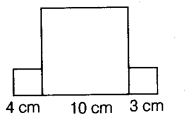
Solution:
We have,
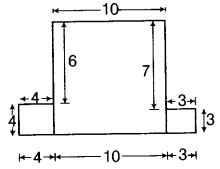
The perimeter of the given figure
= (10 + 3 + 3 + 3 + 7 + 10 + 6 + 4 + 4 + 4) cm
= 54 cm
Question 29.
In the given figure all triangles are equilateral and AB = 8 units. Other triangles have been formed by taking the mid points of the sides. What is the perimeter of the figure?
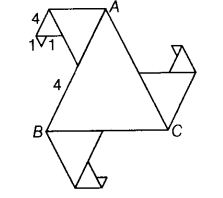
Solution:
We have given, all the triangles are equilateral and AB = 8 units
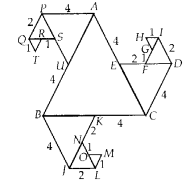
Now, perimeter of the given figure = AE + EF + FC + GH + HI + ID + DC + CK + KN + NO + OM + ML + LJ + JB + BU + US + SR + RT+TQ + QP + PA
= (4 + 2 + 1 + 1 + 1 + 2 + 4 + 4 + 2 + 1 + 1 + 1 + 2 + 4 + 4 + 2 + 1 + 1 + 1 + 2 + 4) units
= 45 units
Question 30.
Length of a rectangular field is 250 m and width is 150 m. Anuradha runs around this field 3 times. How far did she run? How many times she should run around the field to cover a distance of 4 km?
Solution:
Let ABCD be the given rectangular field where length = AB = 250 m and breadth = AD = 150 m

The perimeter of the rectangle ABCD
= 2(AB + AD)
= 2(250 + 150) m
= 2(400) m = 800 m
Since, Anuradha runs around the field 3 times.
∴ She covers a distance of 3 × 800 m
= 2400 m = 2 km 400 m [ ∵ 1 km = 1000 m]
Now, the number of times she will run to cover the distance of 4 km or 4000 m \(=\frac{4000}{800}=5\)
The perimeter of the given figure = (10 + 3+ 3+ 3 + 7 +10 + 6 + 4 + 4 + 4) cm = 54 cm
Question 31.
Bajinder runs ten times around a square track and covers 4 km. Find the length of the track.
Solution:
Let a be the side of the square track.
Perimeter of the square track = 4a
Bajinder runs ten times around the square track and covers 4 km.
i.e., 10 × 4a = 4 km
⇒ 40a = 4 × 1000 m [∵ 1 km = 1000 m]
⇒ \(a=\frac{4 \times 1000}{40} \mathrm{m}=100 \mathrm{m}\)
∴ Length of the track = 4a
= 4 × 100 m = 400 m
Question 32.
The lawn in front of Molly’s house is 12 m × 8 m, whereas the lawn in front of Dolly’s house is 15 m × 5 m. A bamboo fencing is built around both the lawns. How much fencing is required for both?
Solution:
The perimeter of the lawn in front of Molly’s house = 2(length + breadth)
= 2(12 + 8) m = 2(20) m = 40 m
The perimeter of the lawn in front of Dolly’s house = 2(length + breadth)
= 2(15 + 5) m = 2 × 20 m = 40 m
∴ Total length of fencing for both the lawns = (40 + 40) m = 80 m
Question 33.
The perimeter of a regular pentagon is 1540 cm. How long is its each side?
Solution:
The perimeter of the regular pentagon = 1540 cm
⇒ 5 × side = 1540 cm
⇒ side \(=\frac{1540}{5} \mathrm{cm}=308 \mathrm{cm}\)
∴ Each side of the regular pentagon is 308 cm.
Question 34.
The perimeter of a triangle is 28 cm. One of its sides is 8 cm. Write all the sides of the possible isosceles triangles with these measurements.
Solution:
Let ∆ABC be an isosceles triangle, where AB = 8 cm
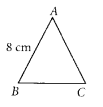
Case I:
If AB = BC
AB = BC = 8 cm
Perimeter of the triangle ABC = 28 cm
⇒ AB + BC + CA = 28 cm
⇒ 8 cm + 8 cm + CA = 28 cm
⇒ 16 cm + CA = 28 cm
⇒ CA = 28 cm – 16 cm = 12 cm
∴ Sides are 8 cm, 8 cm and 12 cm
Case II:
If BC = CA
Perimeter of the triangle ABC = 28 cm
⇒ AB + BC + CA = 28 cm
8 cm + 2BC = 28 cm
⇒ 2BC = 28 cm – 8cm = 20 cm
⇒ BC = 10 cm
∴ Sides are 10 cm, 10 cm and 8 cm
Question 35.
The length of an aluminium strip is 40 cm. If the lengths in cm are measured in natural numbers, write the measurement of all the possible rectangular frames which can be made out of it. (For example, a rectangular frame with 15 cm length and 5 cm breadth can be made from this strip.)
Solution:
Perimeter of rectangular frame = Length of the aluminium strip
⇒ 2(length + breadth) = 40 cm
⇒ length + breadth \(=\frac{40}{2} \mathrm{cm}=20 \mathrm{cm}\)
∴ The possible measurement of rectangular frames are 1 cm × 19 cm, 2 cm × 18 cm, 3 cm × 17 cm, 4 cm × 16 cm, 5 cm × 15 cm, 6 cm × 14 cm, 7 cm × 13 cm, 8 cm × 12 cm, 9 cm × 11 cm, 10 cm × 10 cm
Question 36.
Base of a tent is a regular hexagon of perimeter 60 cm. What is the length of each side of the base?
Solution:
Perimeter of the regular hexagon = 60 cm
⇒ 6 × side = 60 cm
⇒ side \(=\frac{60}{6} \mathrm{cm}=10 \mathrm{cm}\)
∴ Each side of the base is 10 cm.
Question 37.
In an exhibition hall, there are 24 display boards each of length 1 m 50 cm and breadth 1 m. There is a 100 m long aluminium strip, which is used to frame these boards. How many boards will be framed using this strip? Find also the length of the aluminium strip required for the remaining boards.
Solution:
Length of display board = 1 m 50 cm
= 1.50 m
Breadth of display board = 1 m
Perimeter of one display board
= 2(length + breadth) = 2(1.50 + 1) m
= 2(2.50) m = 5 m
∴ Perimeter of 24 display boards
= (24 × 5) m = 120 m
Number of boards will be framed using the aluminium strip of 100 m long \(=\frac{100}{5}=20\)
∴ The length of the aluminium strip required to frame the remaining boards
= 120 m – 100 m = 20 m
Question 38.
In the above question, how many square metres of cloth is required to cover all the display boards? What will be the length in metres of the cloth used, if its breadth is 120 cm?
Solution:
Length of display board = 1 m 50 cm
= 1.5 m
Breadth of display board = 1 m
∴ Area of 24 display boards = 24(l × b)
= 24(1.5 × 1) m2= 24 × 1.5 m2= 36 m2
Therefore, 36 m2 cloth is required to cover all the display boards.
Now, breadth of cloth = 120 cm \(=\frac{120}{100} \mathrm{m}\)
∴ Length of cloth \(=\frac{\text { area }}{\text { breadth }}\)
\(=\frac{36 \times 100}{120} \mathrm{m}=30 \mathrm{m}\)
Question 39.
What is the length of outer boundary of the park shown in figure? What will be the total cost of fencing it at the rate of Rs. 20 per metre ? There is a rectangular flower bed in the center of the park. Find the cost of manuring the flower bed at the rate of Rs. 50 per square metre.
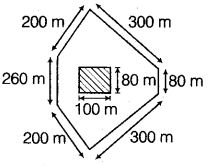
Solution:
The length of outer boundary of the park = (200 + 300 + 80 + 300 + 200 + 260) m
= 1340 m
∴ Cost of fencing the park at the rate of Rs. 20 per metre = Rs. (20 × 1340) = Rs. 26800
Area of the flower bed = (100 × 80) m2 = 8000 m2
Now, the cost of manuring the flower bed at the rate of Rs. 50 per square metre
= Rs. (50 × 8000)
= Rs. 400000
Question 40.
Total cost of fencing the park shown in figure is Rs 55000. Find the cost of fencing per metre.
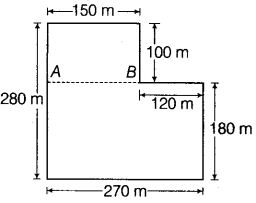
Solution:
Perimeter of the park
= (150 + 100 + 120 + 180 + 270 + 280) m
= 1100 m
∴ Cost of fencing the park per metre
\(=\frac{\text { Total cost of fencing }}{\text { Perimeter of the park }}\)
\(=\mathrm{Rs} \cdot\left(\frac{55000}{1100}\right)=\mathrm{Rs} .50\)
Question 41.
In the given figure each square is of unit length
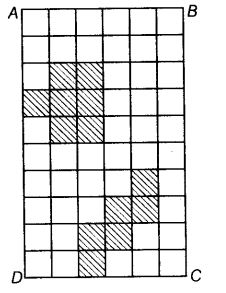
(a) What is the perimeter of the rectangle ABCD ?
(b) What is the area of the rectangle ABCD ?
(c) Divide this rectangle into ten parts of equal area by shading squares. (Two parts of equal area are shown here)
(d) Find the perimeter of each part which you have divided. Are they all equal?
Solution:
We have given each square is of unit length, where length = 10 units and breadth = 6 units
(a) Perimeter of ABCD = 2 (length + breadth)
= 2(10 + 6) units
= 2 × 16 units = 32 units
(b) Area of ABCD = length × breadth
= (10 × 6) sq units = 60 sq units
(c) Since, there are several ways to divide this rectangle into 10 parts, from which one of the ways is shown below :
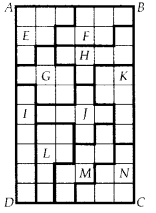
So, the above figure shows that there are 10 part$ of equal area i.e., E, F, G, H, I, J, K, L, M and N.
(d) The perimeter of each part is 12 units. Yes, the perimeter of each part is equal.
Question 42.
Rectangular wall MNOP of a kitchen is covered with square tiles of 15 cm length (see figure). Find the area of the wall.
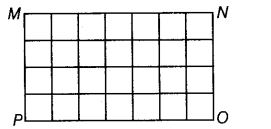
Solution:
Area of one square tile with side 15 cm = (15 × 15) cm2 = 225 cm2
Since, the wall is covered with 28 square tiles.
∴ Area of the wall = (225 × 28) cm2
= 6300 cm2
Question 43.
Length of a rectangular field is 6 times its breadth. If the length of the field is 120 cm, find the breadth and perimeter of the field.
Solution:
Length of rectangular field = 120 cm
According to question,
⇒ 6(breadth) = 120 cm
⇒ breadth \(=\frac{120}{6} \mathrm{cm}=20 \mathrm{cm}\)
∴ Perimeter of the field = 2(length + breadth)
= 2(120 + 20) cm
= 2(140) cm = 280 cm
Question 44.
Anmol has a chart paper of measure 90 cm × 40 cm, whereas Abhishek has one which measures 50 cm × 70 cm. Which will cover more area on the table and by how much?
Solution:
The area of Anmol’s chart paper = (90 × 40) cm2 = 3600 cm2
And the area of Abhishek’s chart paper = (50 × 70) cm2 = 3500 cm2
∴ The chart paper of Anmol will cover more area on the table than that of Abhishek by (3600 – 3500) cm2 = 100 cm2
Questiom 45.
A rectangular path of 60 m length and 3 m width is covered by square tiles of side 25 cm. How many tiles will there be in one row along its width? How many such rows will be there? Find the number of tiles used to make this path?
Solution:
Length of rectangular path = 60 m
= 6000 cm
Width of rectangular path = 3 m = 300 cm
Side of a square tile = 25 cm
Number of tiles will be in one row along the width of the path \(=\frac{\text { width of the path }}{\text { side of a tile }}=\frac{300}{25}=12\)
Width of path \(=\frac{\text { width of the path }}{\text { side of a tile }}=\frac{300}{25}=12\)
Number of rows \(=\frac{\text { length of the path }}{\text { side of a tile }}\)

Question 46.
How many square slabs each with side 90 cm are needed to cover a floor of area 81 sq m?
Solution:
Area of the floor = 81 m2 = 81 × 10000 cm2
= 810000 cm2
Area of one square slab = (90 × 90) cm2 = 8100 cm2
The required number of square slabs
\(=\frac{\text { Area of the floor }}{\text { Area of a square slab }}=\frac{810000}{8100}=100\)
Question 47.
The length of a rectangular field is 8 m and breadth is 2 m. If a square field has the same perimeter as this rectangular field, find which field has the greater area.
Solution:
We have given, perimeter of the rectangular field
= perimeter of the square field
⇒ 2(length + breadth) = 4 × side
⇒ 2(8 + 2) m = 4 × side
⇒ 2(10) m = 4 × side ⇒ 20 m = 4 × side
⇒ \(\frac{20}{4} \mathrm{m}=\text { side } \Rightarrow \mathrm{side}=5 \mathrm{m}\)
Now, area of the rectangular field
= length × breadth = 8m × 2m = 16m2
Area of the square field= side × side = 5m × 5m = 25m2
∴ The square field has greater area than that of rectangular field.
Question 48.
Parmindar walks around a square park once and covers 800 m. What will be the area of this park?
Solution:
The perimeter of the square park = 800 m
⇒ 4 × side = 800 m
⇒ side \(=\frac{800}{4} \mathrm{m}=200 \mathrm{m}\)
∴ Area of the square park = side × side
= (200 × 200) m2
= 40000 m2
Question 49.
The side of a square is 5 cm. How many times does the area increase, if the side of the square is doubled?
Solution:
Side of the square = 5 cm
∴ Area of the square = side × side
= 5 cm × 5 cm = 25 cm2 …… (1)
Side of a new square
= 2 (side of the given square)
= 2 × 5 cm = 10 cm
∴ Area of the new square = side × side = 10 cm × 10 cm
= 100 cm2 …… (2)
Thus, (1) and (2) shows that the area will be increased by 4 times.
Question 50.
Amita wants to make rectangular cards measuring 8 cm × 5 cm. She has a square chart paper of side 60 cm. How many complete cards can she make from this chart? What area of the chart paper will be left?
Solution:
The square chart of length 60 cm can be divided exactly in 7 parts each of length 8 cm along one side of chart paper and exactly in 12 parts each of length 5 cm along other side of chart paper.
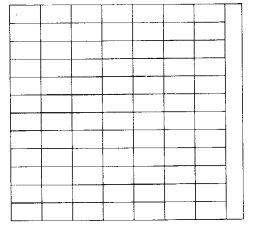
The figure shows that the number of rectangular cards which can be made from the square chart paper is 7 × 12 = 84
Now, area of the square chart paper
= (60 × 60) cm2 = 3600 cm2
Area of one rectangular card = (8 × 5) cm2
= 40 cm2
∴ Area of 84 rectangular cards
= 84 × 40 cm2 = 3360 cm2
∴ Area of remaining chart paper = (3600 – 3360) cm2 = 240 cm2
Question 51.
A magazine charges Rs. 300 per 10 sq cm area for advertising. A company decided to order a half page advertisement. If each page of the magazine is 15 cm × 24 cm, what amount will the company has to pay for it?
Solution:
The area of one page of magazine = length × breadth = (15 × 24) cm2 = 360 cm2
∴ Area of the half page of magazine
\(=\frac{360}{2} \mathrm{cm}^{2}=180 \mathrm{cm}^{2}\)
Cost of advertising for 10 cm2 = Rs. 300
∴ Cost of advertising for 180 cm2
\(=\mathrm{Rs} . \frac{300}{10} \times 180=\mathrm{Rs} .5400\)
Question 52.
The perimeter of a square garden is 48 m. A small flower bed covers 18 sq m area inside this garden. What is the area of the garden that is not covered by the flower bed? What fractional part of the garden is covered by flower bed? Find the ratio of the area covered by the flower bed and the remaining area.
Solution:
The perimeter of the square garden = 48 m
\(\Rightarrow 4 \times \text { side }=48 \mathrm{m} \Rightarrow \text { side }=\frac{48}{4} \mathrm{m}=12 \mathrm{m}\)
Area of the square garden = side × side
= 12 m × 12 m = 144 m2
Area of the small flower bed = 18 m2
∴ The area of the garden that is not covered by the flower bed = 144 m2 – 18 m2 = 126 m2
The required fractional part of the garden which is covered by the flower bed \(=\frac{\text { Area of the flower bed }}{\text { Area of the square garden }}\)
\(=\frac{18}{144}=\frac{1}{8}\)
The ratio of the area covered by the flower bed and the remaining area
\(=\frac{18}{126}=\frac{1}{7} \text { i.e.. } 1 : 7\)
Question 53.
Perimeter of a square and a rectangle is same. If a side of the square is 15 cm and one side of the rectangle is 18 cm, find the area of the rectangle.
Solution:
We have given,
Perimeter of the square = Perimeter of the rectangle
4 × side = 2(length + breadth)
⇒ 4 × 15 cm = 2(18 cm + breadth)
⇒ \(\frac{4 \times 15}{2} \mathrm{cm}\) = 18 cm + breadth
⇒ 30 cm = 18 cm + breadth
⇒ (30 – 18) cm = breadth
⇒ breadth = 12 cm
Now, area of the rectangle length × breadth = (18 × 12) cm2 = 216 cm2
Question 54.
A wire is cut into several small pieces. Each of the small pieces is bent into a square of side 2 cm. If the total area of the small squares is 28 square cm, what was the original length of the wire?
Solution:
Length of one piece
= Perimeter of the square
= 4 × 2 cm = 8 cm
Let the number of pieces be n.
We have given, total area of n squares = 28 cm2
⇒ n (side)2 = 28
⇒ n (2)2 = 28
⇒ n × 4 = 28
⇒ \(n=\frac{28}{4}=7\)
The original length of the wire
= Number of pieces × length of one piece
= 7 × 8 cm = 56 cm
Question 55.
Divide the park shown in the figure of question 40 into two rectangles. Find the total area of this park. If one packet of fertilizer is used for 300 sq m, how many packets of fertilizer are required for the whole park?
Solution:
Area of rectangle ABCD = length × breadth
= (150 × 100) m2
= 15000 m2
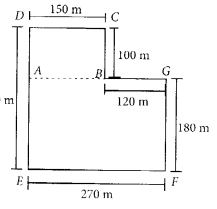
And area of rectangle AGFE = length × breadth
= (270 × 180) m2
=48600 m2
∴ Total area of the park = 15000 m2 + 48600 m2
= 63600 m2
Number of packets of fertilizer used for 300 m2 = 1
∴ Number of packets of fertilizer used for \(63600 \mathrm{m}^{2}=\frac{63600}{300}=212\)
Question 56.
The area of a rectangular field is 1600 sq m. If the length of the field is 80 m, find the perimeter of the field.
Solution:
Area of the rectangular field = 1600 m2
⇒ length × breadth= 1600 m2
⇒ 80 m × breadth = 1600 m2
⇒ breadth \(=\frac{1600 \mathrm{m}^{2}}{80 \mathrm{m}}=20 \mathrm{m}\)
Now, perimeter of the rectangular field = 2(length + breadth)
= 2(80 + 20) m
= 2 × 100 m = 200 m
Question 57.
The area of each square on a chess board is 4 sq cm. Find the area of the board.
(a) At the beginning of game when all the chess men are put on the board, write area of the squares left unoccupied.
(b) Find the area of the squares occupied by chess men.
Solution:
We have given,
The area of one square on a chess board = 4 sq cm
Since, there are 64 squares on a chess board.
∴ Area of the chess board = 64 × 4 sq cm
= 256 sq cm
(a) At the beginning of game when all the chess men are put on the board, 32 squares left unoccupied.
Area of the squares left unoccupied
= 32 × area of one square
= 32 × 4 sq cm = 128 sq cm
(b) Since, 32 squares are occupied by chess men.
∴ Area of the squares occupied by chess men = 32 × (area of one square)
= 32 × 4 sq cm = 128 sq cm .
Question 58.
(a) Find all the possible dimensions (in natural numbers) of a rectangle with a perimeter 36 cm and find their areas.
(b) Find all the possible dimensions (in natural numbers) of a rectangle with an area of 36 sq cm, and find their perimeters.
Solution:
(a) Perimeter of the rectangle = 36 cm
⇒ 2(length + breadth) = 36 cm
⇒ length + breadth \(=\frac{36}{2} \mathrm{cm}=18 \mathrm{cm}\)
∴ The possible dimensions of the rectangle and their areas as follows:
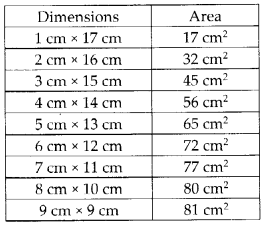
(b) The area of the rectangle = 36 sq cm
⇒ length × breadth = 36 sq cm
∴ The possible dimensions of the rectangle and their perimeters as follows:
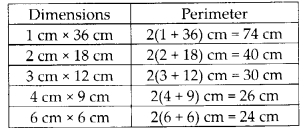
Question 59.
Find the area and perimeter of each of the following figures, if area of each small square is 1 sq cm.
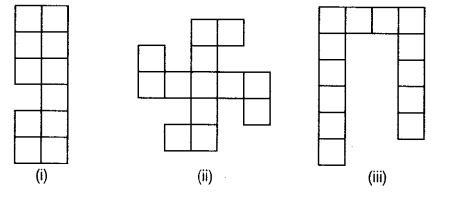
(i) In the given figure (i), there are 11 small squares with the area 1 sq cm of each.
∴ Area of the given figure = (11 × 1) sq cm
= 11 sq cm
Perimeter of the given figure = (18 × 1) cm
= 18 cm
(ii) In the given figure (ii), there are 13 small squares with the area 1 sq cm of each.
∴ Area of the given figure = (13 × 1) sq cm
= 13 sq cm
Perimeter of the given figure = (28 × 1) cm
= 28 cm
(iii) In the given figure (iii), there are 13 small squares with the area 1 sq cm of each.
∴ Area of the given figure = (13 × 1) sq cm
= 13 sq cm
Perimeter of the given figure = (28 × 1) cm
= 28 cm
Question 60.
What is the area of each small square in the given figure if the area of entire figure is 96 sq cm. Find the perimeter of the figure.
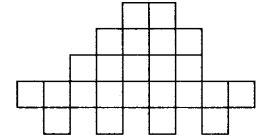
Solution:
We have 24 small squares in the figure.
Area of the entire figure = 96 sq cm
∴ The area of one small square \(=\frac{96}{24} \mathrm{sqcm}\)
= 4 sq cm
Thus, area of each small square = 4 sq cm
⇒ (side) × (side) = 4 sq cm
⇒ side \(=\sqrt{4} \mathrm{cm}=2 \mathrm{cm}\) cm = 2 cm
Now, perimeter of the given figure = 34 × 2 cm
= 68 cm
We hope the NCERT Exemplar Class 6 Maths Chapter 6 Mensuration will help you. If you have any query regarding NCERT Exemplar Class 6 Maths Solutions Chapter 6 Mensuration, drop a comment below and we will get back to you at the earliest.